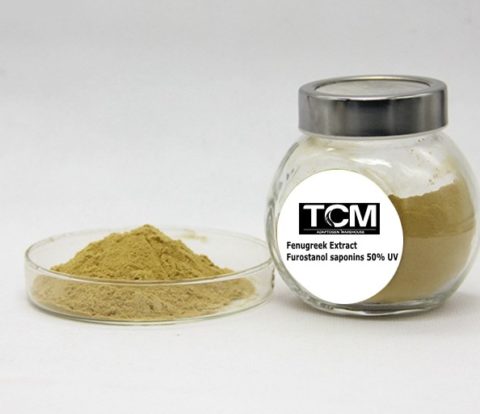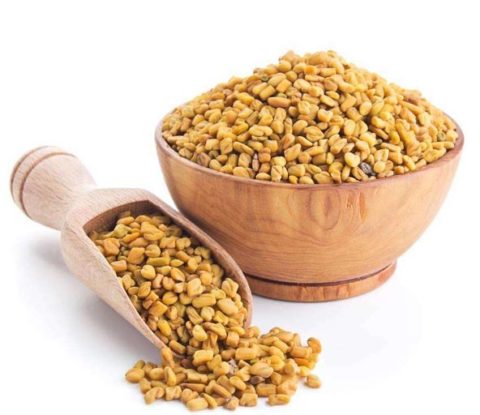
Fenugreek Extract
【Latin Name】: Trigonella foenum-graecum L.
【Other names】: Hu Lu Ba, Common Fenugreek Seed, Semen Trigonellae
【Part Used】: Seeds
【Appearance】: Brown yellow powder
【Active Ingredients】:L-4-Hydroxyisoleucine, Furostanol saponins
【Specifications】: 4-Hydroxyisoleucine 20%, 40%, 60%, 90%, 98%; 50% Furostanol saponins; 10:1, 20:1
【Test Method]: HPLC/UV/TLC
【CAS No. 】: 55399-93-4(4-Hydroxyisoleucine)
【Molecular Formula】:C6H13NO3(4-Hydroxyisoleucine)
【Test method】: HPLC
【Appearance】: Brownish yellow powder
【Particle size】: 95% pass 80 mesh
Brief Introduction
Trigonella foenum-graecum, commonly known as fenugreek, is a popular herb in Arabic regions and India. It has traditionally been used to enhance libido and masculinity. Fenugreek has also been used to alleviate blood sugar metabolism problems like diabetes. Fenugreek tea has also been recommended to new mothers to enhance milk production. Though evidence for this claim is limited, it seems to be accurate. One human study has shown that fenugreek supplementation can also enhance Testosterone, but since additional evidence shows conflicting results, further evidence is needed to confirm this effect.
Fenugreek’s most well-known compound is 4-hydroxyisoleucine, which works to normalize glucose metabolism. The other compounds, called trigonelline, galactomannan, and trigoneosides, also work together to provide benefits for blood sugar. Supplementing fenugreek may cause body secretions, including urine, to smell like maple syrup. This is due to a metabolite called sotolon. Fenugreek seeds and extract comes from the plant Trigonella foenum-graecum L and has been used historically for various uses such as antispasmodic, appetite stimulant, high cholesterol, wounds, blood cleanser, and expectorant effects. It is derived from both Ayurveda (mostly) and Traditional Chinese Medicine (to a lesser degree) and unlike most traditional medicines it also appears to be a condiment. There are some other traditional usages of fenugeek seeds including using them in beer as an at-home remedy for anxiety and hopelessness.
Chemical Analysis
Trigonella foenum-graecum seeds (Fenugreek seeds; the main active component of this plant) tend to contain:
-Trigonelline, a betaine molecule also found in high levels in alfalfa and Coffee
-4-hydroxyisoleucine and its precursor, 2-oxoglutarate.
-Protodioscin similar to Tribulus terrestris
-The two Trigoneosides, Trigofaenoside A and Glycoside D
-Diosgenin and Yamogenin
-GII, a compound currently unnamed
-3-hydroxy-4,5-dimethyl-2(5H)-furanone (HDMF; aka. sotolon), the causative agent for a maple syrup scent of body excretions
-Small phenolics such as Protocatechuic acid at 85.50ng/mg (ethyl acetate extract) or 31.25ng/mg (water extract), quinic acid at 15.97ng/mg (ethyl acetate extract) 165.55ng/mg (water extract), and gallic acid at 3.93ng/mg (ethyl acetate extract) or 3.10ng/mg (water extract)
-Apigenin-7-O-glycoside (1955.55ng/mg in the ethyl acetate extract)
-Luteolin-7-O-glycoside (725.50ng/mg in the ethyl acetate extract)
-Vitamin C at 576.50ng/mg (ethyl acetate extract) and less in the water extract (6.82ng/mg)
-Minerals such as potassium (603+/-15mg/100g), Magnesium (42+/-5mg/100g), Calcium (75+/-9mg/100g) Zinc(2.4+/-0.2mg/100g), Iron (25.8+/-1.2mg/100g), and both Manganese and Copper (0.9+/-0.1mg/100g)
Indications in TCM(Traditional Chinese Medicine)
Therapeutic effect: tonifies the Yang
Properties: bitter, warm
Channels entered: Kidney, Liver
Functions and clinical use:
Warms the Kidney, disperses Cold and alleviates pain: used for Deficient Kidney Yang patterns accompanied by accumulation of Cold and Stagnant Qi. Manifestation include abdominal or flank distension and pain or hernia-like disorders. Also used for Cold Damp Leg Qi.
Major combinations:
With Fruktus Feoniculi Vulgaris (Xiao Hui Xiang) for Cold Deficient hernia-like disorders in the abdomen and testicles, or, in extreme cases, contraction of the scrotum and a localized sensation of icy cold. This combination is also used for dysmenorrhea.
With Radix Aconinti Carmichaeli Praeparata (Fu Zi) and Fructus Psoraleae Corylifoliae (Bu Gu Zhi) for pain and cold sensation in the lower abdomen, lower extremities and lower back.
With Fructus Chaenomelis Lgenariae (Mu Gua), Radix et Caulis Jixueteng (Ji Xue Teng) and Fructus Psoraleae Corylifoliae (Bu Gu Zhi) for symptoms associated with Cold Damp Leg Qi such as soreness and swelling in the legs; sensations of heaviness, cold, and pain exacerbated by exposure to cold; a deep, slow pulse; and a white, greasy moss on the tongue.
With Fructus Rubi (Fu Pen Zi) and Rhizoma Polygonati (Huang Jing) for spermatorrhea, back pain and decreased sexual function from Deficient Kidneys.
Pharmacological Actions
1. Interactions with Hormones
1). Testosterone
In rats, oral intake of 10-35mg/kg Fenugreek furostanols for 4 weeks has caused an increase in the weight of the levator ani muscle (thought to be indicative of anabolic actions in males) with no significant influence on circulating testosterone levels. Prostate weight was not altered in this study.
Possible androgenic effects independent of testosterone, although no evidence exists to support the notion that this is at all a powerful androgenic effect.
Fenugreek has once been shown at 500mg (brand name Testofen) to increase serum testosterone over a period of 8 weeks in resistance trained males relative to placebo (experiencing a decline in testosterone relative to baseline) although another study (which noted a decrease in DHT, a testosterone metabolite) failed to find any significance influence on total or free testosterone using similar methodology and a study using 600mg of Testofen for a period of 6 weeks in otherwise healthy man has similarly failed to find an increase in testosterone.
In regards to DHT, the one study to measure DHT noted a 9.42% decrease relative to baseline over 8 weeks supplementation of 500mg Fenugreek. Mixed results on an increase in testosterone in otherwise healthy men, although there appears to be support for the 5alpha-reductase properties of Fenugreek via the reduction in DHT.
2). Thyroid Hormones
In rats given exogenous thyroid hormones (T4 and T3) in order to induce high blood sugar, 220mg/kg of the seeds of Fenugreek was able to suppress the rise in blood glucose and the rise of thyroid hormones; the potency of which being comparable to 500mg/kg Allium sativum and 10mg/kg propyl thiouracil (known anti-thyroid as active control).
2. Sexuality and Pregnancy
1). Libido
Fenugreek may also enhance male libido when ingested at 600mg a day (Testofen brand name, 50% Fenusides) in two divided doses for 6 weeks. The primary measurement was the self-reported score on the Derogatis interview for sexual functioning-self report (DISF-SR) and there was a reported global improvement as well as significant improvements on the subscales of satisfaction with orgasm and sexual desire; this study was not affiliated with the producer of the supplement.
2). Lactation
Fenugreek is a commonly recommended herb for increasing milk production in pregnant women, and is seen by some as one of the few herbs with promising evidence. It is told (traditionally) that fenugreek ‘stimulates sweat production’ and that this influences milk production as the two structures (sweat glands and milk glands) are similar.
A few trials have been conducted on the matter, and fenugreek seems to be able to enhance milk production in recent mothers more than placebo. In which control and placebo had 31.1+/-12.9mL and 38.8+/-16.3mL respectively, the fenugreek group was able to produce 73.2+/-53.5mL after consuming at least 3 cups (200mL) of fenugreek tea (Still tea, Humana) for three days.
The mechanism of action is not specifically known, but may be related to phytoesteogens or diosgenin. Not many studies have detected the presence of Fenugreek bioactives in breast milk, but one assessing the anti-oxidant capacity of breast milk from mothers drinking Fenugreek tea failed to find a significant difference relative to placebo. Limited evidence to support Fenugeek enhancing milk production, but Fenugreek Tea does have preliminary evidence in support of this traditional usage.
3). Pregnancy
Fenugreek, at dosages of 800mg/kg bodyweight or above in rats (128mg/kg human estimated dose), is potentially a teratogenic substance that may cause birth defects when consumed by a pregnant woman; the mechanism of teratogenesis is hypothesized to be through inhibiting stem cell differentiation.
3. Interactions with Glucose Metabolism
1). Absorption
Fenugreek as a whole can attenuate the absorption of carbohydrates by acting as an alpha-amylase and maltase inhibitor (starch and maltose digestive enzymes, respectively). This has been noted in vivo with Fenugreek Oil (15% Fish Oil by weight) at 5% of feed in diabetic rats is associated with a 51% reduced AUC of plasma glucose following a meal associated with reduced carbohydrate enzyme activity (46% and 37% reduction for pancreatic α-amylase and maltase, respectively; 52% and 35% for plasma). The reduction of serum glucose following a meal has been noted in otherwise healthy humans.
2). Mechanisms
It has been noted that the steroidal saponins per se do not possess significant influence on glucose metabolism and that de-gumming Fenugreek (removing soluble fibers) reduces the ability of Fenugreek to attenuate postprandial blood glucose spikes. In diabetic rabbits, purified GII at 50mg/kg is able to reduce blood glucose to near normal concentrations and reduce HbA1c.
3.) Pancreas
A protective effect on pancreatic beta-cells has been noted with fenugreek seed ingestion in diabetic rats which has been noted with the isolated steroidal saponin content. 4-hydroxyisoleucine (henceforth 4OH-Ile), mostly exclusive to fenugreek (beyond some bacterial synthesis either naturally or via modification) can induce insulin secretion from pancreatic beta-cells under conditions of high glucose concentration with little to no efficacy at normal serum glucose concentrations. 4OH-ILE does not appear to interfere with other inducers of insulin secretion such as Leucine and in doses of 50mg/kg bodyweight can reduce glucose, LDL, and insulin in diabetic mice.
4). Interventions
In streptozotocin-induced diabetic rats, 1,500mg/kg of fenugreek seeds daily for 21 days was associated with a 58% reduction in blood glucose levels (still 116% higher than true control) with no significant influence on insulin. Reduction in blood glucose has also been noted in Alloxan-induced diabetic rats (2-8g/kg of the seeds).
21 days of 1,500mg/kg Fenugreek is associated with improvements in the hepatic enzymes G6P (59% of the change seen via diabetes was reversed) and G6P dehydrogenase (30%) as well as improving hepatic glycogen storage; phosphofructokinase, reduced during diabetes, was unaffected. A beneficial alteration of hepatic enzymes has also been noted in Alloxan-induced diabetic rats in both the kidneys and liver (5% of the rat diet)
One study using high doses of Fenugreek (2-8g daily) in alloxan induced diabetic rats noted that the healthy control rats also experienced a reduction in blood glucose. This appears to be relevant in humans with Type I diabetes (100g defatted Fenugreek) as well as Type II diabetics, where a 53% increase in insulin sensitivity was noted via HOMA relative to the control group using 1g daily of a hydroalcoholic extract. Benefits for glycemic control have been seen with the seeds themselves, defatted seed extract and whole seed powder. Fenugreek has been successfully incorporated into a bread product at 5% fenugreek flour by weight without exerting adverse taste effects onto the bread, this has been used in vivo to lower the glucose spikes after eating the bread in diabetics.




